
Podocarpus totara (; the tōtara is a species of podocarp tree endemic to New Zealand. It grows throughout the North Island, South Island and rarely on Stewart Island / Rakiura in lowland, montane and lower subalpine forest at elevations of up to 600 m.

Podocarpus is a genus of conifers, the most numerous and widely distributed of the podocarp family, the Podocarpaceae. The name comes from Greek πούς + καρπός. Podocarpus species are evergreen shrubs or trees, usually from 1 to 25 m tall, known to reach 40 m (130 ft) at times. The cones have two to five fused cone scales, which form a fleshy, berry-like, brightly coloured receptacle at maturity. The fleshy cones attract birds, which then eat the cones and disperse the seeds in their droppings. About 97 to 107 species are placed in the genus depending on the circumscription of the species.

Podocarpus drouynianus is a species of podocarp native to the relatively high rainfall southwestern corner of Western Australia, where it is known by the name emu berry, wild plum or native plum although it is not a true plum. The Noongar name for the plant is koolah.
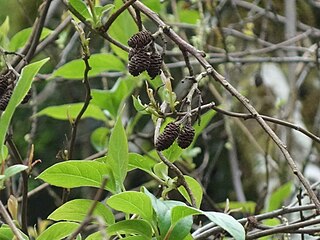
Alnus formosana, the Formosan alder, is a species of alder endemic to Taiwan. It is a medium-sized tree, up to 20 metres (66 ft) in height and 40 centimetres (16 in) in trunk diameter.

Podocarpus elatus, known as the plum pine, the brown pine, the Illawarra plum or the Queensland Christmas tree, is a species of Podocarpus endemic to the east coast of Australia, in eastern New South Wales and eastern Queensland.

Agathis macrophylla known as Pacific kauri, is a coniferous tree native to the islands of the southwestern Pacific Ocean in tropical humid lowlands and lower montane regions, notably in Fiji, Vanuatu, and the Santa Cruz Islands. The Pacific kauri is one of the largest and fastest growing species in its genus, and is important in forestry.
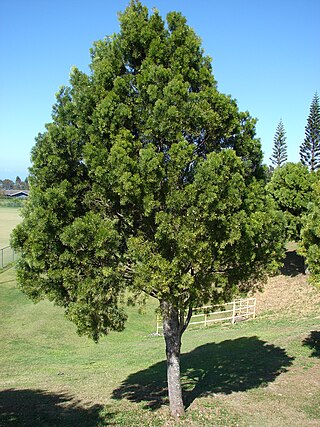
Afrocarpus gracilior is a species of coniferous tree in the family Podocarpaceae known as benet in Marakwet and East African yellowwood, African fern tree, or bastard yellowwood in English
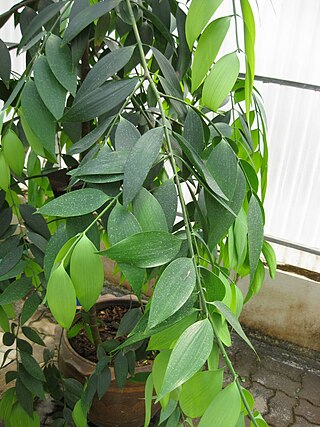
Nageia wallichiana is a species of conifer in the family Podocarpaceae. It is a tree 10–54 m high, found in Brunei, Cambodia, China, India, Indonesia, Laos, Malaysia, Myanmar, Thailand, and Vietnam. Nageia wallichiana is the most widely distributed species among the seven species in the genus Nageia. If the land areas of China and Japan are excluded, its distribution nearly coincides with that of the genus and includes both the western outliers in India and the easternmost part on Normanby Island. It is one of the most extensive conifer ranges recognized and is similar to Dacrycarpus imbricatus and Podocarpus neriifolius.
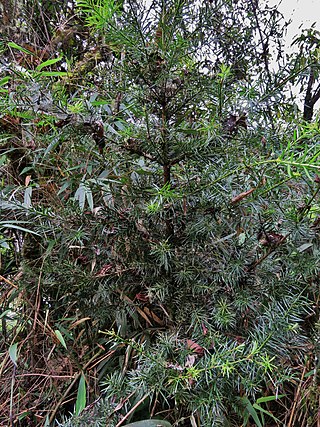
Podocarpus glomeratus is a species of conifer tree in the family Podocarpaceae. It is native to the montane rainforests of Bolivia, Ecuador, and Peru; between 1800–3600 meters above sea level.
Podocarpus magnifolius is a species of conifer in the family Podocarpaceae. It is found in Bolivia, Colombia, Peru, Panama and Venezuela.

Podocarpus milanjianus is a species of conifer in the family Podocarpaceae. It is native to the highlands and mountains of tropical Africa.
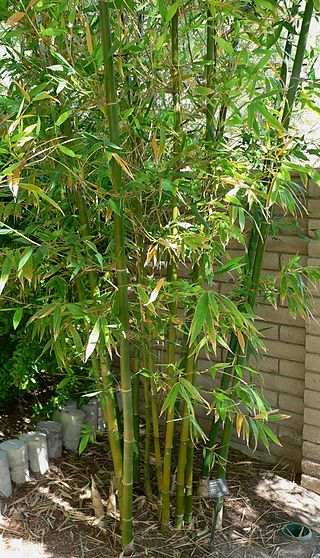
Bambusa oldhamii, known as giant timber bamboo or Oldham's bamboo, is a large species of bamboo. It is the most common and widely grown bamboo in the United States and has been introduced into cultivation around the world. It is densely foliated, growing up to 20 metres tall in good conditions, and can have a diameter of up to 10 centimetres.

Dendrocnide meyeniana or the poisonous wood nettle is a species of tree in the family Urticaceae, native to the thickets and secondary forests of Taiwan and the Philippines. The specific epithet meyeniana honors Franz Meyen, who collected the type specimen in Manila during his world cruise.

Acer kawakamii is an Asian species of maple, found only in Taiwan. The species is sometimes confused with another Taiwanese tree, Acer morrisonense. This species has been known to reach 20 metres tall. Leaves are non-compound, the blade narrowly ovate, up to 11 cm long by 4.5 cm wide, with serrate margins but no lobes.

Cassipourea malosana is a species of plant native to tropical Africa.

Schima superba is a species of flowering plant in the tea family Theaceae, native to subtropical areas of Vietnam, southern China, Hainan, Taiwan, and the Ryukyu Islands. With Pinus massoniana it often dominates forests from 100 to 800 m in elevation. It is used as a street tree in a number of southern Chinese cities.

Rhododendron kawakamii is a plant endemic to Taiwan. It is also called Kawakami's rhododendron, as the type specimen was collected by Takiya Kawakami and others from Mount Niitaka. This species is the only native, epiphytic, yellow flowered rhododendron in Taiwan, and is scattered in the fog forest belt of the island at an altitude of about 1,500 to 2,500 m. It was first published as a new species by Bunzo Hayata in 1911. The wild community was assessed as "near-threatened" in the Taiwan Red Book of Vascular Plants in 2017.
Crotalaria similis, also known as the Pingtung Curara pea, belongs to the family Fabaceae and genus Crotalaria. It is a perennial crawling herb, an endemic species of Taiwan which the distribution is limited to the Eastern seaside of the Hengchun Peninsula.
Piper kawakamii, also known as the Kawakamii pepper, is a flowering plant in the family Piperaceae. It is a native endemic species in Taiwan. The plant is mainly distributed in the Hengchun Peninsula. It was collected by Takiya Kawakami at the Kuraru Community, on July 2, 1906. In 1911, the plant was published by Bunzō Hayata as a new species. The type specimen of this plant is being preserved in the Botanical Gardens, Graduate School of Science, the University of Tokyo, Japan.and the Herbarium of Taiwan Forest Research Institute
Lonicera kawakamii, also known as Yushan honeysuckle or Kawakami’s honeysuckle, is a species of flowering plant in the family Caprifoliaceae. It is endemic to Taiwan, where it is found at altitudes between 3000 and 3900 meters. It as rated as “Vulnerable” in the “Red List of Vascular Plants of Taiwan, 2017”.





















